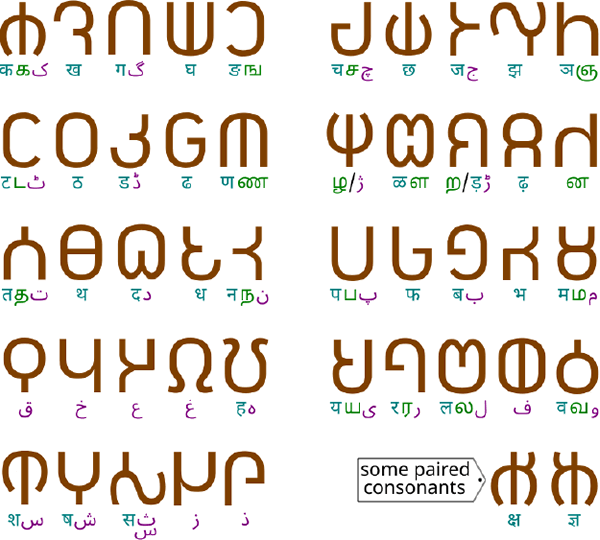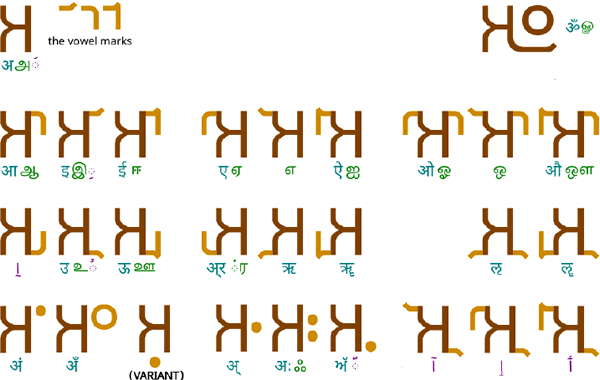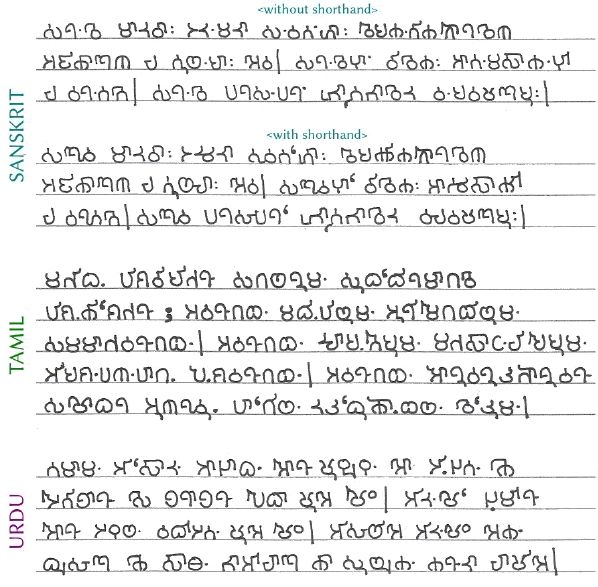The Indian subcontinent is a land of diverse cultures and peoples. The various languages spoken by its inhabitants, while remarkably diverse, share some common features with each other. The most common aspect of all these languages is the almost unchanging inventory of phonemes, and thus, letters used therein. What complicates the situation is that many different writing systems are present pertaining to the same sounds but used for different languages. This makes it tough to understand one another across languages through script even if speech can be understood mutually between the different languages of the Indian subcontinent.
A solution to this issue would be to have a common script between these languages for easy communication between different regions of the subcontinent. This is not to say that the original scripts being used now should be discarded, but a blanket script should also be used in order to cover all of these peoples’ languages.
Neobrahmi (or Navabrahmi) is a script devised by Punya Pranava Pasumarty capable of achieving this kind of unison between the various scripts of the Indian subcontinent and keeping it simple to learn. As the name suggests, Neobrahmi is a revival of the ancient Brahmi script which is thought to have given rise to all modern day South Asian scripts albeit not the Arabic based scripts used for Kashmiri/ Urdu/ Sindhi. Neobrahmi stylizes and modifies the original Brahmi symbols with the following aims kept in mind:
Neobrahmi intrinsically covers more than 90% of all sounds used in all languages of the Indian subcontinent, and can adapt letters with some marks in order to accommodate some more sounds. The following are some trivia:
Below is an image showing the 45 letters and 2 paired consonants labeled with their equivalents in Sanskrit, Tamil and Urdu/ Kashmiri:

At the bottom right of the image, the 2 standard paired consonants 'kša' and 'jña' are shown. These are the most frequently used ones in several Indian languages, but other such conjunctions could also be used for the purpose of shorthand as will be discussed later. Note that these are not plain consonants but syllables of their respective consonants with the inherent vowel 'a' like in most Indian languages. Other vowels can be represented on these consonant letters by introducing vowel marks attached to the letter in various positions, orientations and combinations.
The image below shows the various vowel marks/diacritics used in Neobrahmi. There are 3 basic vowel marks (shown in orange) which can be attached to the consonant letter in question to impart various vowel sounds to it. These marks can also be used on the 'blank consonant' letter, shown at the top-left of the image below and labeled as 'अ'. This blank consonant has no inherent sound, but when it is marked with vowel marks/diacritics it assumes the sound of that vowel, thus becoming a standalone vowel; if it has no vowel marks, it assumes the sound of 'a' like the other consonants do. The list of vowel mark combinations used in Neobrahmi is given below, shown on the blank consonant and labeled like in the previous image showing equivalents in Sanskrit, Tamil and Urdu / Kashmiri / Sindhi:

The vowel mark combinations can produce 20 distinct vowels as shown here. Those vowels with only purple labels are sounds used almost exclusively in Kashmiri. The mark labeled as 'अ्र', while not strictly a vowel, is the Sanskrit 'repha' which adds an 'r' sound to the consonant that it is joined to and is used commonly in many Indian languages.
In the bottom row there are several uses of dots on the blank consonant. These are called embellishments and they modify the nature of the consonant part of any letter in different ways. The mark labeled as 'ਅੱ' has the function of stressing the following consonant like the Punjabi 'adhak'. The mark labeled as '(VARIANT)' modifies some consonants' sounds like in the following: ( ح)→(ہ) ,(ض)→(ز) ,(ص)→(س) ,(ظ)→(ذ) ,(ط)→(ت ). This is used mainly for Urdu and Kashmiri.
The loop shown among these marks nasalizes the vowel part of the letter like the 'chandrabindu' mark in Devanagari or 'nun ghunna' of Urdu, and this features in the Neobrahmi 'Om' symbol as well (shown at the topright of the image).
The use of dots in various places can get a little confusing or ambiguous when handwritten, so there are some shorthand rules that can be followed to avert such misreadings. The dot at the top-right of a letter, the 'anusvara' mark, can be replaced with an inverted apostrophe, and the dot at the middleright, used as a muting mark/'halanta', with a hyphen attached to the letters in concern in various ways:
For the sake of convenience of writing quickly, one can combine 2 to 3 consonants into conjunct ligatures using this hyphen that replaced the middle-right dot mark. This hyphen could be attached to either the right of the preceding letter (or in lieu of its right portion), the left of the following letter (or in lieu of its left portion), or it could just join the 2 letters into one ligature by connecting them in the middle.
Apart from the 2 paired consonants seen earlier, labeled 'क्ष' and 'ज्ञ', all other such ligatures are not standard and are merely used for shorthand. Also note that, since the mark for stressing the following consonant (the Punjabi 'adhak' mark) looks like '.', the preferred symbol for a sentence-break is '|' instead.
To demonstrate this use of shorthand, have a look at the sample texts given below of 'Article 1 of the Universal Declaration of Human Rights'. The text is provided in 3 languages with the help of information from Omniglot.com: Sanskrit, Tamil and Urdu. The Sanskrit version alone is provided in both standard and shorthand versions since they look significantly different from each other, while in other languages, they aren't very distinguishable. The Tamil and Urdu versions are shown using the shorthand and all versions show the use of '|' as a sentence-break mark.

सर्वे मानवाः स्वतन्त्राः समुत्पन्नाः वर्तन्ते अपि च, गौरवदृशा अधिकारदृशा च समानाः एव वर्तन्ते। एते सर्वे चेतना-तर्क-शक्तिभ्यां सुसम्पन्नाः सन्ति। अपि च, सर्वेऽपि बन्धुत्व-भावनया परस्परं व्यवहरन्तु।
மனிதப் பிறவியினர் சகலரும் சுதந்திரமாகவே பிறக்கின்றனர்; அவர்கள் மதிப்பிலும் உரிமைகளிலும் சமமானவர்கள். அவர்கள் நியாயத்தையும் மனசாட்சியையும் இயற்பண்பாகப் பெற்றவர்கள். அவர்கள் ஒருவருடனொருவர் சகோதர உணர்வுப் பாங்கில் நடந்துகொள்ளல் வேண்டும்.
تمام انسان آزاد اور حقوق و عزت کے اعتبار سے برابر پیدا ہوۓ ہیں۔ انہیں ضمیر اور عقل ودیعت ہوئی ہے۔ اسلیۓ انہیں ایک دوسرے کے ساتھ بھائی چارے کا سلوک کرنا چاہیۓ۔
All human beings are born free and equal in dignity and rights. They
are endowed with reason and conscience and should act towards one another
in a spirit of brotherhood.
(Article 1 of the Universal Declaration of Human Rights)
Bhāratalipi Unified Indian Script (BLUIS), Charunagari, Deccan Lipi, Devadeshi, Ethiofarsi, Españabugida, Farsi Alefbet, Featural Lojban Abjad, Haruf-e-Tana, Palimukhi, Neobrahmi, SEAscript, West Eurolex
Constructed scripts for: Ainu | Arabic | Chinese languages | Dutch | English | Hawaiian | Hungarian | Japanese | Korean | Lingala | Malay & Indonesian | Persian | Tagalog / Filipino | Russian | Sanskrit | Spanish | Taino | Turkish | Vietnamese | Welsh | Other natural languages | Colour-based scripts | Tactile scripts | Phonetic/universal scripts | Constructed scripts for constructed languages | Adaptations of existing alphabets | Fictional alphabets | Magical alphabets | A-Z index | How to submit a constructed script
[top]
You can support this site by Buying Me A Coffee, and if you like what you see on this page, you can use the buttons below to share it with people you know.

If you like this site and find it useful, you can support it by making a donation via PayPal or Patreon, or by contributing in other ways. Omniglot is how I make my living.
Note: all links on this site to Amazon.com, Amazon.co.uk
and Amazon.fr
are affiliate links. This means I earn a commission if you click on any of them and buy something. So by clicking on these links you can help to support this site.
[top]